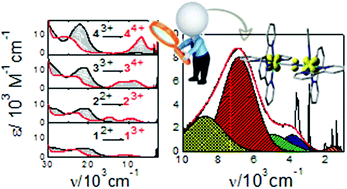Exploring the localized to delocalized transition in non-symmetric bimetallic ruthenium polypyridines†
Abstract
In this work, we report the evolution of the properties of the inter-valence charge transfer (IVCT) transition in a family of cyanide-bridged ruthenium polypyridines of general formula [RuII(tpy)(bpy)(μ-CN)RuIII(bpy)2(L)]3/4+ (tpy = 2,2′,6′,2′′-terpyridine; bpy = 2,2′-bipyridine; L = Cl−, NCS−, 4-dimethylaminopyridine or acetonitrile). In these complexes, the redox potential difference between both ruthenium centers (ΔE) is systematically modified. A decrease in ΔE causes a red shift of the energy and an intensity enhancement of the observed IVCT transitions. For L = acetonitrile, the IVCT band becomes narrower and asymmetrical, and shows very little dependence on the nature of the solvent, suggesting a delocalized configuration, although a non-symmetrical one. Also, additional electronic transitions of low energy are clearly resolved in this complex. The observed variation in the properties of the IVCT transitions can be understood on the basis of DFT calculations, that point to increasing mixing between the dπ orbitals of both Ru ions.



 Please wait while we load your content...
Please wait while we load your content...